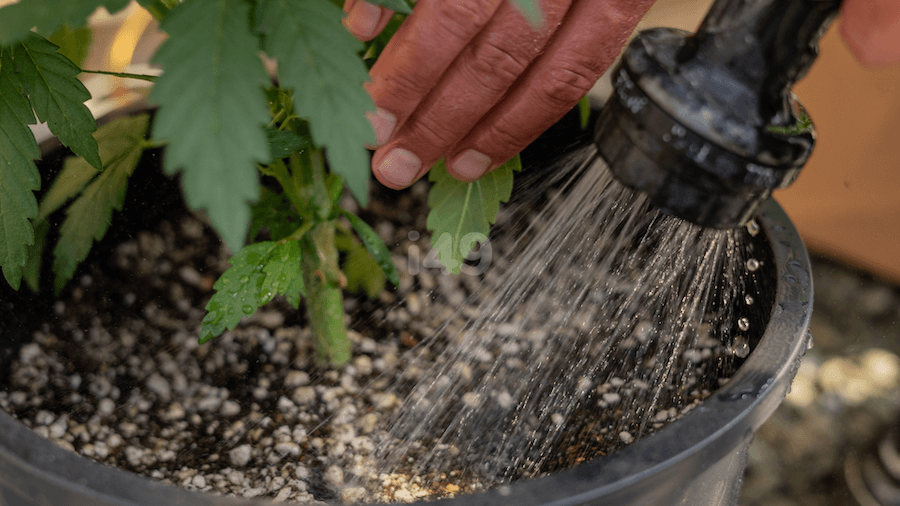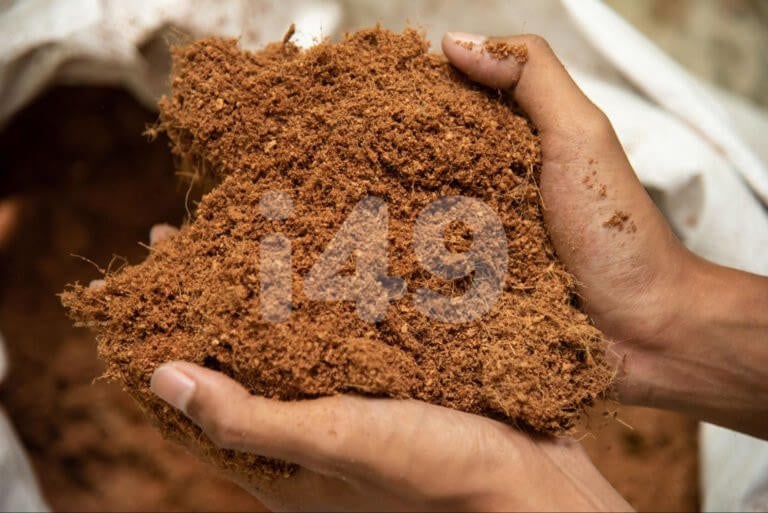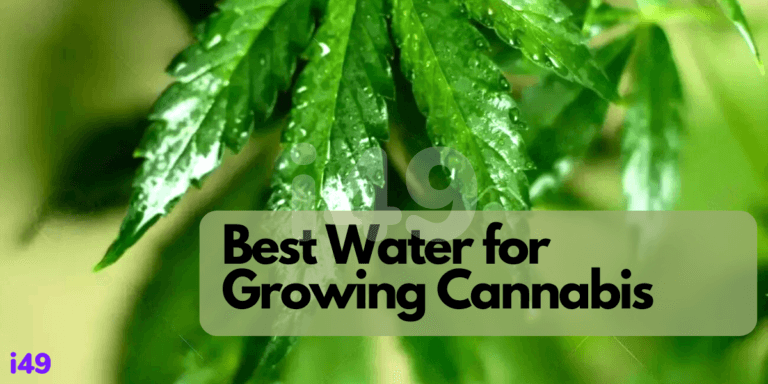Watering weed sounds easy, right? Well, that’s not quite the case.
We believe it shouldn’t give you trouble, so we’ve simplified the process. We’re going to tell you how often to water, how much H2O to use and some tips to avoid over or underwatering.
Once you understand the tips and tricks that lie behind watering marijuana, you’re all good to go. Now let’s get down to business:
How often to water cannabis?
How often to water cannabis generally boils down to every 2–3 days. Keep in mind that there’s no fixed rule about it. The process depends on different variables like temperature, humidity, or where you grow them.
Be sure to consider your environment and different factors to create the best marijuana watering schedule for you.
Watering weed plants: when to do this?
Similar to the frequency, knowing when to water weed plants revolves around different variables. To be on the safe side, simply familiarize yourself with signs that suggest it’s time for a drink:

How to tell if your plants are thirsty
Here are a few signs that suggest you need to water marijuana plants:
- For growing cannabis in soil, it’s when you stick your finger an inch deep (up to the first knuckle), and it feels dry.
- When the pot feels lighter than usual, cannabis has drained all the water from the soil.
- You’ll notice drooping plants and curling leaves.
- It’s past thirsty and downright underwatering weed when you see weak and discolored leaves that feel crispy and look burnt.
Closely observe your plants for early recognition to avoid worse damage.
How much water to give marijuana plants
You’ll have adjusted your watering schedule for weed on countless occasions by the time it’s ready to harvest. That’s because certain aspects like the below influence the amount required:
Size of plants
As herbs get bigger, they demand more water to satisfy their growing needs. For instance, a seedling should be slightly moist at all times. This changes as the weed vegetative state begins, increasing intake to a gallon every 2–3 days and two gallons after that.
Flowering cannabis may need more at the beginning but less towards the end.
Type of soil
Watering weed should be less for heavy soils since they hold moisture longer. You risk overwatering and damaging your cannabis when you give too much, in this case.
Light sandy soils have a hard time absorbing water, so they require a lot of it. Consider learning your soil’s attributes to get the best out of it.
Temperature
Here’s another factor that dictates how often you should water marijuana plants. High temperatures rush growth and evaporation, so cannabis frequently needs more water.
Whether you’re growing indoors or outdoors, always maintain the optimal cannabis temperature range. Too high or too little is a gamble you shouldn’t take.
Weed watering tips: how to do this?
Now for the most important part about watering your beauties; the actual watering!
Here are a couple of weed watering tips to keep in mind:
- Prioritize efficiency over frequency—allow your cannabis to soak properly rather than giving them H2O often. Watering to 30% of the pot’s capacity should be sufficient.
- Try to maintain the optimal pH range right from the get-go—depending on its source; water might affect the pH level. Keep pH testers and adjusters handy to prevent imbalances.
- Weed and feed watering—mix nutrients with water and test the solution to maintain the right pH range.
- Let runoff water actually run off—dispose of the stale, murky liquid in the runoff tray. It’s the perfect breeding ground for pests, mold, and other growers’ nightmares.
- Water from the middle to the edges—this way, the roots drink enough first, and any nutrients at the top go directly to them.
Now, let’s explore different ways to water marijuana plants:

Hand carry water
Hand-carrying water isn’t as tedious as it sounds, especially with few plants growing near a water source. It doesn’t require capital, and it helps keep your cultivation on the down-low.
Use a water pump
Watering weed using a pump is appropriate for big set-ups. These battery, gas, or electric-powered beauties may lighten the load, but they’re noisy, costly to buy, use, and maintain.
Slow-drip irrigation
Slow-drip irrigation is quiet, low-maintenance, and best of all, free! Poke small holes into a water bottle cap and leave it upside down at the plant’s base. You only have to refill the bottles occasionally.
Drip line irrigation
Drip line irrigation is exceptionally handy for watering outdoor weed plants in hot weather. It ensures consistently even distribution and gives you control over the rate and amount of water.
Garden hose
Using a garden hose is quite straightforward. Before connecting one to the tap, confirm that the pH range and other content are in the right range.
Collecting rainwater
Literally sent from heaven, rainwater makes watering weed free! It can be risky in highly industrialized areas, so test the pH to be sure.
How to avoid overwatering and underwatering?
Giving too much or too little when watering cannabis can be catastrophic. It causes harm to the plant while creating the ideal setting for marijuana pests, fungi, and other nuisances.
To avoid overwatering weed plants:
- Increase the time between watering, or reduce the amount of water you give
- Don’t water if you find the soil wet or muddy by the finger test
- Add coarse materials like pebbles to help improve air circulation
- Make sure you have good drainage—20% of the water should flow out.
To avoid underwatering weed:
- Water if the soil is dry after using the finger test
- Mix in light soils with heavy ones to improve the capacity to hold water
- Reduce the time between watering, or increase the amount of water you give
How and when to flush your weed plants?
Flushing marijuana is continuously running pure water through the soil to remove nutrients and minerals, thus leaving it (the soil) clean. Every grower needs to learn how to flush weed plants. Here are the basics:
Step 1: Ensure the nute-free water you’ll use is well within the optimal pH range.
Step 2: Water your weed plant and let it sit to absorb the nutes in the soil.
Step 3: In about 15 minutes, water again to allow those collected to drain out.
Step 4: Test the runoff with a Total Dissolved Solids (TDS) meter to confirm that it’s below 50ppm. It’s good enough if the ppm is closest to the water’s.
Step 5: Until you achieve your goal, water marijuana plants with pH-neutral, nute-free H2O.
Wondering why anyone would throw away precious nutes? Well, there are three occasions when flushing is necessary:
- A week before harvest—this forces marijuana to use up nutes left in its system. It removes chemicals and excess chlorophyll from the buds while enhancing the quality, taste, and aroma.
- Nutrient problems and pH imbalances—flushing is like a cleanse when it comes to weed and feed watering. It purges toxins and resets the plant’s system.
- Making a change in the nute cycle—mixing the different feeds and boosters can be toxic. It’s wise to clean up traces of the previous one before introducing another.
FAQ related to watering weed
We understand that watering marijuana plants can be a tricky business. So, just in case we forgot anything, we’ve answered some of the most frequently asked questions. Knock yourself out:
How dry should weed be before watering?
Short answer? Not desert dry! Dip your finger into the soil—the initial inch ought to feel dehydrated, but the rest downwards; slightly moist. That’s how dry it should be before watering weed plants.
How often should I water cannabis seedlings?
Twice to several times a day. A cannabis seedling should be somewhat humid at all times. This isn’t a license to flood the poor thing, so be careful—use a spray bottle to lightly mist when you think it needs it.
Remember to maintain the right humidity for weed to avoid doing more harm than good.
Should I water my plant at night?
Yes, if that’s ideal for you. Watering outdoor weed plants in hot and dry climates is best at night, evenings, or other times when the temperature is lowest. Early morning before the sun rises is great; they’ll have all they need for their biological processes.
How much water does a weed plant need per day?
It’s wise not to approach watering marijuana as a daily thing. Avoid frustrating it with frequent watering—give 30% of the water capacity of your container. Observe after about 2–3 days, then confirm how dry the soil is with the finger test.
Refill the percentage if need be, and repeat the regimen. Regarding outdoor plants, water every 2–3 days when you find the soil dry using the test. Either way, remain keen—be quick to adjust your marijuana watering schedule when you need to.
Quench your weed’s thirst along with your own
That’s all for now, folks! Provide your marijuana relief from thirst without going too far or doing too little. Keep a watch on your crop to identify when they’re ready for watering. Choose the option most convenient for you.
Learn about the correct pH and ppm levels, and don’t forget to consider your pot’s individual environment and needs at all times.
The i49 website aims to quench your thirst for cannabis knowledge as well. Browse the blogs and learn the finer details about watering weed, and explore so much more.













